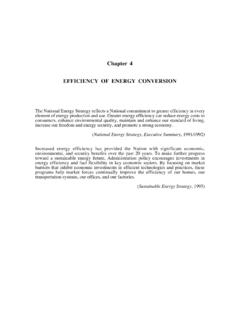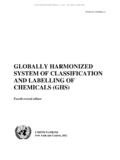Transcription of Chapter 8 PETROLEUM - ems.psu.edu
1 Chapter 8. PETROLEUM . For the foreseeable future, oil will remain a critical fuel for the United States and all other industrialized nations. [In order to make the economy less dependent on oil,] the National Energy Strategy proposes initiatives to (1) reduce the economic consequences of disruptions in world oil markets, and (2) increase domestic oil and PETROLEUM product supplies. (National Energy Strategy, Executive Summary, 1991/1992). The growing level of oil consumption raises potential economic and national security concerns. In addition to emphasizing efficient use of oil products and enhancing fuel flexibility, national energy policy must address declining domestic production levels with minimum interference with market forces.
2 The Administration's policy is to improve the economics of domestic oil production by reducing costs, in order to lessen the impact on this industry of low and volatile prices. (Sustainable Energy Strategy, 1995). 138 Chapter 8. PETROLEUM (or crude oil) is a complex, naturally occurring liquid mixture containing mostly hydrocarbons, but containing also some compounds of oxygen, nitrogen and sulfur. It is often referred to as the black gold. The Rockefellers, the Rothschilds, the Gettys, the Hammers and the royal families of the Persian Gulf area would certainly agree. A view at Fortune magazine's list of billionaires confirms it: the Sultan of the oil-rich Brunei, on the island of Borneo, has been at the very top for quite some time.
3 Saudi Arabia's King Fahd is up there as well. After World War II, the huge oil reserves in the Middle East became available, at a very low cost, and they rapidly revolutionized the way we live. Indeed, the twentieth century . with all the dramatic changes that it has brought to society is probably best characterized as the century of oil. A fascinating account of the epic quest for oil, money and power is given by Daniel Yergin, in his Pulitzer prize-winning book The Prize (see Further Reading, p. 461). Resources Reserves Production to date Rest of World Middle East Former USSR. Rest of America United States 0 500 1000 1500 2000 2500.
4 Quadrillion BTU. FIGURE 8-1. World distribution of PETROLEUM resources and reserves. [Source: W. Fulkerson et al., Scientific American, September 1990, p. 129.]. Most of the world's PETROLEUM is to be found in the Middle East, as shown in Figure 8-1. and in more detail in Figure 8-2. Figure 8-1 also illustrates the fact that the world reserves and resources of crude oil are orders of magnitude smaller than those of coal. In particular, it is seen that the reserves are just an order of magnitude larger than the annual oil PETROLEUM 139. consumption (see Figure 8-3). Obviously, United States imports a large portion of the PETROLEUM that it consumes.
5 This increasing trend is likely to continue. The economic, political and policy implications of this state of affairs are discussed in Chapter 21. Saudi Arabia Iraq UAE. Kuwait Iran Venezuela Former USSR. Mexico United States China 0 50 100 150 200 250 300. Billions of barrels FIGURE 8-2. Distribution of major PETROLEUM reserves in the world. [Source: The New York Times, September 2, 1990.]. PETROLEUM Formation PETROLEUM forms by the breaking down of large molecules of fats, oils and waxes that contributed to the formation of kerogen (see Chapter 6). This process began millions of years ago, when small marine organisms abounded in the seas.
6 As marine life died, it settled at the sea bottom and became buried in layers of clay, silt and sand. The gradual decay by the effect of heat and pressure resulted in the formation of hundreds of compounds. Because PETROLEUM is a fluid, it is able to migrate through the earth as it forms. To form large, economically recoverable amounts of oil underground, two things are needed: an oil pool and an oil trap. An oil pool, which is the underground reservoir of oil, may literally be a pool or it could be droplets of oil collected in a highly porous rock such as sandstone. An oil trap is a non-porous rock formation that holds the oil pool in place.
7 Obviously, in order to stay in the ground, the fluids oil and associated gas must be trapped, so that they cannot flow to the surface of the earth. The hydrocarbons accumulate in reservoir rock, the porous sandstone or limestone. The reservoir rock must have a covering of an impervious rock that will not allow the passage of the hydrocarbon fluids to the surface. 140 Chapter 8. Consumption Production 25. Million barrels per day 20.. 15 .. 10 .. 5. 0. 1950 1960 1970 1980 1990 2000. FIGURE 8-3. PETROLEUM production and consumption in the last 45 years. [Source: Energy Information Administration.]. The impervious rock covering the reservoir rocks is called a cap rock.
8 As shown in Figure 8-4, oil traps consist of hydrocarbon fluids held in porous rock covered by a cap rock. A hot, wet climate fosters the growth of large amounts of organisms. If this growth takes place in a shallow sea, the eventual drying out of the environment and evaporation of the sea water leaves behind large deposits of salt. Salt makes an excellent cap rock for a reservoir. If these conditions are enhanced by a gentle geological folding of the subsurface rocks, the rock folding can produce very large reservoirs, with the impervious salt deposits acting as a cap. These are precisely the conditions that prevailed in the Middle East, giving rise to the enormous deposits of oil found in that region of the world.
9 Properties of PETROLEUM The elemental composition of PETROLEUM is much less variable than that of coal: 83-87%. carbon, 11-16% hydrogen, 0-4% oxygen plus nitrogen, and 0-4% sulfur. Note that most crude oils contain substantially more hydrogen than coals. Only a brief discussion is needed here regarding the distribution of these elements among the thousands of compounds found in PETROLEUM . Most of the compounds in PETROLEUM contain from five to about twenty carbon atoms. Many of them consist of straight chains of carbon atoms (surrounded by hydrogen atoms), as illustrated below: PETROLEUM 141. EARTH'S SURFACE. SALT DOME. CAP Gas Gas CAP.
10 CAP. OIL OIL. Brine Brine POROUS. ROCK. IMPERVIOUS. ROCK. FIGURE 8-4. Representative geologic structure of an oil trap: a salt dome. C C C C C C C C C C C C C C C C C C C C C C C C C C . Compounds having branched chains and rings of carbon atoms are also present. Here are some examples: 142 Chapter 8. Compounds of the types shown above with chains of carbon atoms, either branched or straight, are called paraffins. All paraffins have the molecular formula CnH 2n+2. For example, n = 8 for a compound called octane. The physical state of the paraffins depends on the number of carbon atoms in the molecule. Paraffins with less than five carbon atoms are gases at ordinary temperatures.




